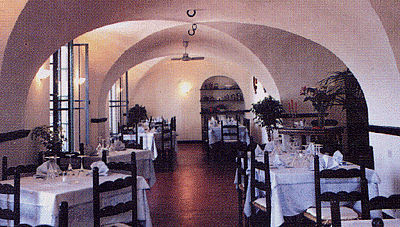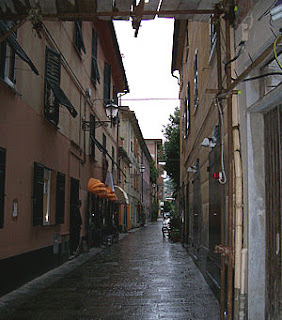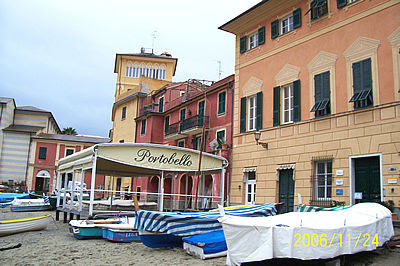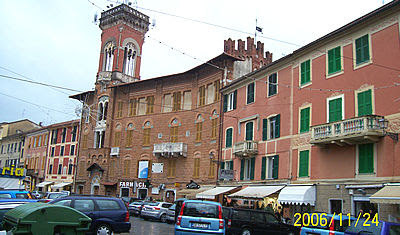
On the morning of Wednesday 22 November 2006 we said good-bye to the delightful Florence and set off on our train journey to Sestri Levante. At Pisa we had to change trains - there-in lies potential disaster.
The trip from Florence to Pisa went without a hitch. We arrived there at lunchtime, checked in our bags at the station, and set off on foot in search of lunch. We were not impressed by Pisa near the railway station, at the opposite end of the city from the leaning tower. We never got to see that hallowed tower - not enough time. However, we stumbled across a yummy and reasonably priced lunch at the Trattoria Bandini on Via San Paolo. It struck us once again that most restaurants and trattorias in Italy use good linen and napkins in their table settings.
Then it was back to the station for the next leg of the journey. We were not used to the split-second accuracy of the arrival and departure times of the Italian trains, so we happily got onto a train which arrived at our designated platform 5 minutes before it was supposed to depart, only to find it was the wrong one - we should have waited another 3 minutes for the Milan train! This meant the train whisked through Sestri Levante without stopping and we had to go all the way to Genova and from there catch another train back to Sestri Levante. It took 45 minutes on the fast train from Sestri Levante to Genova, but 90 minutes in the opposite direction on the all-stops run.

We stayed at the Hotel Grande Albergo, a four-star hotel that wants to be thought of as very grand, from the haughty receptionist to the hand-painted tiles on the bathroom floor. When we arrived, travel weary and a bit scruffy in our walking shoes and backpacks after a day on the trains, the receptionist peered at us down her nose when she at last decided to notice us. We suspect that if we had been dressed in pearls and bow tie the reception would have been warmer. We thought they were trying to compete with the ambience of the Italian Riviera which lies a bit to the north of Sestri Levante.

So once we were able to dump our bags and freshen up we rewarded ourselves with a nice dinner at the restaurant Il Brigantino down the road from the hotel.
Sestri Levante is an ancient merchant and maritime centre in Liguria, Tuscany, Italy, on the Gulf of Tigulli. It is approximately 56 kilometers south of Genova. Like so many villages of the Liguria, it is surrounded by an enchanting landscape of sea and mountains.

The original settlement of Sestri Levante was actually on a peninsula, with the beautiful Baia del Silenzio (or Bay of Silence, also known as "Portobello") on one side and Baia delle Favole (or Bay of Fables) on the other. The Bay of Fables was named in honour of Hans Christian Andersen, who lived in Sestri Levante for a short time.
The ruins of an old castle on the peninsula, dating back to 1440, are now incorporated in a hotel. Although the current castle was built only in 1920, it was built using the remains of older constructions. This castle also had a tower in which Marconi performed his experiments with radio signals.

The Bay of Silence was named by the poet Giovanni De Scalzo. This bay, because of the transparency of the sea, the natural beauty of its position and the picturesque houses which surround it, was the favourite resort of many famous visitors, among them Lord Byron, Goethe, Wagner and Hans C. Andersen.

The following day, Thursday, we spent walking along the Cinque Terre, but more about that in the next installment. While we are talking about Sestri Levante, here are a few more pictures we took on Friday, our last day here. We were quite exhausted after the walk along the Cinque Terra the day before, so Friday was basically a day of rest and gentle strolls through the older parts of Sestri Levante, and lunch at the very quaint Trattoria Millelire with the friendliest waiter. We liked this establishment so much that we went back there for lunch on Saturday before we left for Switzerland.


Once again there were the typically narrow streets, like this one in the centre of the old town.

An interesting difference between the buildings in the old part of Sestri Levante is that the embelishments on the buildings are painted on (rather than sculpted) to look three-dimensional. Have another look at the buildings in this picture of Portobello - these are not built of huge stone blocks; the blocks are painted onto the smoothly plastered wall surface. This technique is known as "chiaroscura"l;

We thought this building was very quaint - those are vines trained up the side of the building, to bear grapes on the roof garden above. What a clever idea!
Throughout our travels in Italy we noticed elaborate roof gardens wherever the buildings are crowded closely together and there are no gardens at ground level.


Lastly, here is the town square, which is not much of a square at all, but it seems to be the centre of activity.

No comments:
Post a Comment